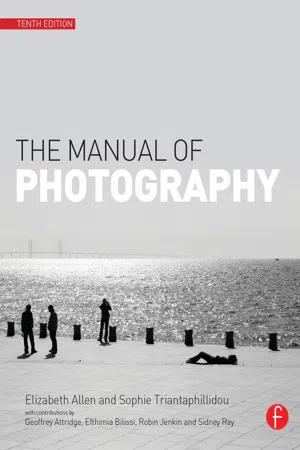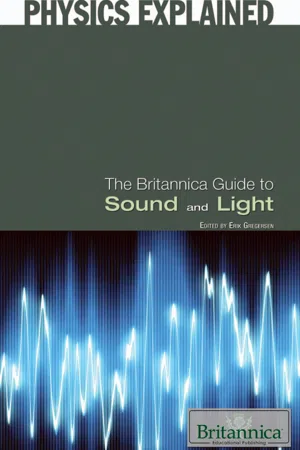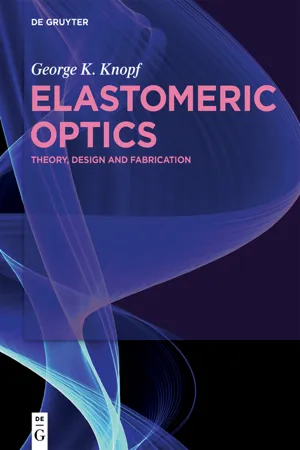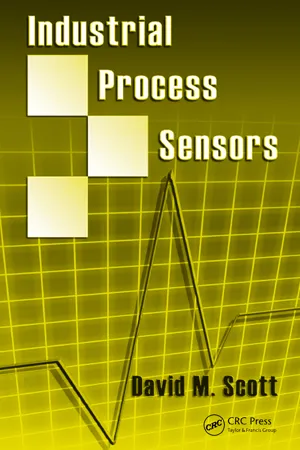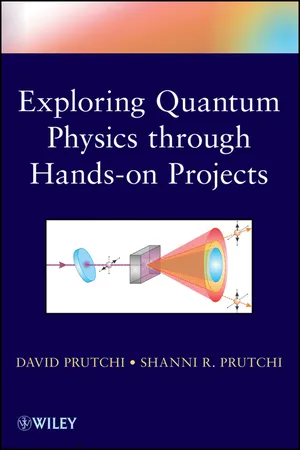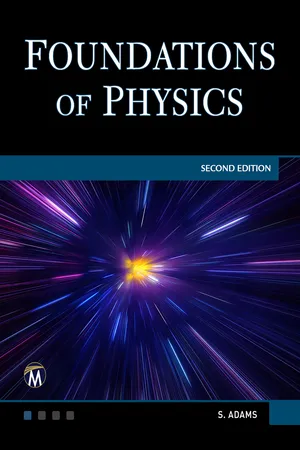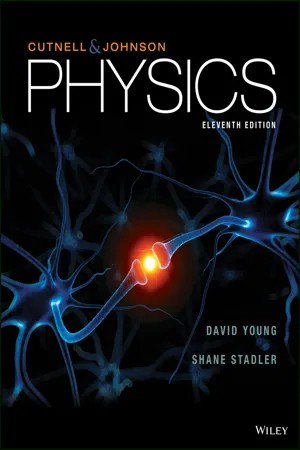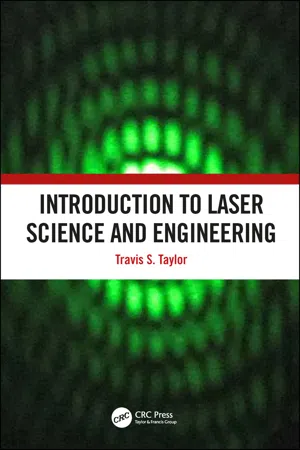Physics
Light Wave
A light wave is a type of electromagnetic wave that travels through space and carries energy. It consists of oscillating electric and magnetic fields that propagate through a medium or vacuum. Light waves have properties such as wavelength, frequency, and amplitude, and they exhibit behaviors like reflection, refraction, and diffraction.
Written by Perlego with AI-assistance
Related key terms
10 Key excerpts on "Light Wave"
- eBook - ePub
- Elizabeth Allen, Sophie Triantaphillidou(Authors)
- 2012(Publication Date)
- Routledge(Publisher)
It is now accepted that a complete understanding of the nature of light must recognize both wave and particle theories as valid. This is termed wave–particle duality and is extended in current scientific theory to all matter at a quantum level: the idea that any object existing in the form of particles must also exhibit wave-like behaviour. THE NATURE OF LIGHT Light is a form of electromagnetic radiation (or radiant flux), which is emitted from various sources, most obviously the sun. Electromagnetic radiation is a self-propagating wave of energy which travels through empty space at a particular speed and consists of oscillations in electric and magnetic fields. As established by Maxwell, all electromagnetic radiation travels at the same speed in vacuum, † that is approximately 2.998 × 10 8 ms −1. When electric charges move, they are accompanied by a magnetic field. If the charges accelerate or decelerate, then disturbances occur in both the electric and magnetic fields and radiation is emitted in a wave motion, carrying energy away from the disturbed charges. The fields oscillate at right angles to each other. They are also at right angles to the direction in which the wave is moving. Furthermore, electromagnetic waves exhibit rectilinear propagation – that is, a single point on a wave, if unimpeded, is propagated in a straight line. Electromagnetic radiation exists at a wide range of wavelengths or frequencies and these are collectively termed the electromagnetic spectrum (see page 35). In general, in photography and digital imaging we are more correctly referring to the visible spectrum – that is, the range of wavelengths of electromagnetic radiation that are detectable by the human visual system - eBook - ePub
Making Physics Fun
Key Concepts, Classroom Activities, and Everyday Examples, Grades K?8
- Robert Prigo(Author)
- 2015(Publication Date)
- Skyhorse(Publisher)
So the particle picture of light was back on the scene. Indeed, the nature of light turned out to be much more interesting than an either-or particle or wave reality. Both descriptions are needed for a full picture of light. This complementary picture is known as the wave-particle duality for light. The dual nature of light, propagating as an electromagnetic wave while interacting with matter through particle-like photons, sums up our present understanding of light. This wave-particle duality is now known to be a universal property of nature. Based on an analogy with the dual nature of light, Louis de Broglie (1892–1987) proposed that matter itself (electrons, atoms, etc.) might show the same duality. He proposed that particles such as electrons might have wave-like features. His ideas were soon put to the test and vindicated when experiments revealed the diffraction and superposition of electrons! All forms of light, both visible and nonvisible, share many fascinating characteristics and properties. Light does not need a medium through which to propagate. It can propagate in a vacuum. Light is made up of oscillating and self-sustaining electric and magnetic fields that interact with matter in a particle-like way (photons). Light travels at a constant speed in a vacuum (299,792,458 meters per second). In a transparent material, light travels at a slower speed, with different frequencies traveling at slightly different speeds. In a vacuum and in uniform transparent materials, light travels in straight lines. Some objects reflect light, some absorb light, and some do both. Light bends— refracts —when it propagates from one transparent medium into another. Visible light comes in a narrow but continuous spectrum of frequencies that we detect as different colors (red to violet). “White” light is composed of light of different colors (red to violet). “Black” is the absence of light - eBook - ePub
- Britannica Educational Publishing, Erik Gregersen(Authors)
- 2010(Publication Date)
- Britannica Educational Publishing(Publisher)
The rules of geometrical optics, developed through centuries of observation, can be derived from the classical electromagnetic-wave model of light. However, as long as the physical dimensions of the objects that light encounters (and the apertures through which it passes) are significantly greater than the wavelength of the electromagnetic wave, there is no need for the mathematical formalism of the wave model. In those circumstances, light is adequately modeled as a collection of rays following the rules of geometrical optics. Most everyday optical phenomena can be handled within this approximation, since the wavelengths of visible light are relatively short (400 to 700 nm). However, as the dimensions of objects and apertures approach the wavelength of light, the wave character of light cannot be disregarded. Many optical effects, often subtle in nature, cannot be understood without a wave model. For example, on close inspection the shadows of objects in parallel light are seen not to be infinitely sharp. This is a consequence of the “bending” of waves around corners—a phenomenon best explained by the wave model. Another class of phenomena involves the polarization of Light Waves. These issues are addressed below.LIGHT AS A WAVE
Newton’s corpuscular model of light was championed by most of the European scientific community throughout the 1700s, but by the start of the 19th century it was facing challenges. About 1802, English physician and physicist Thomas Young showed that an interference pattern is produced when light from two sources overlaps. Though it took some time for Young’s contemporaries to accept fully the implications of his landmark discovery, it conclusively demonstrated that light has wavelike characteristics. Young’s work ushered in a period of intense experimental and theoretical activity that culminated 60 years later in a fully developed wave theory of light. By the latter years of the 19th century, corpuscular theories were abandoned. Before describing Young’s work, an introduction to the relevant features of waves is in order.CHARACTERISTICS OF WAVESFrom ripples on a pond to deep ocean swells, sound waves, and light, all waves share some basic characteristics. Broadly speaking, a wave is a disturbance that propagates through space. Most waves move through a supporting medium, with the disturbance being a physical displacement of the medium. The time dependence of the displacement at any single point in space is often an oscillation about some equilibrium position. For example, a sound wave travels through the medium of air, and the disturbance is a small collective displacement of air molecules—individual molecules oscillate back and forth as the wave passes. - eBook - ePub
Elastomeric Optics
Theory, Design, and Fabrication
- George K. Knopf(Author)
- 2022(Publication Date)
- De Gruyter(Publisher)
2 Light and Optical Waveguides2.1 Light and the Electromagnetic Spectrum
Our understanding about the nature of light has continuously evolved throughout written history [1 ]. Several thousand years ago the ancient Greeks speculated that sources of natural light, such as the Sun or a candle flame, emit tiny particles called corpuscles. This interpretation of light was an accepted truth until the seventeenth century when the Dutch astronomer Christian Huygens (1629–1695) proposed a revolutionary idea. Huygens hypothesized that light was generated by moving waves emanating in all directions from the source through an all-pervasive medium called ether. To support his novel hypothesis Huygens would experimentally show that the notion of Light Waves could explain commonly observed optical phenomenon such as mirror reflections and the light refraction through a transparent medium. However, Huygens’ theory of Light Waves was not universally accepted by all his contemporaries in the scientific community. One of the most vocal opponents of this theory was Sir Isaac Newton who advocated for the particle theory of light in 1704 [2 ]. According to Newton, light behaves as a stream of very small particles that emanate from the source. These streams of particles, or rays, travel in a straight line. The opposing interpretations of light would be debated vigorously amongst the scientific community until 1801 when Thomas Young’s double-slit experiment demonstrated that light rays would indeed interfere with each other like waves.The scientific relationship between light and electromagnetism was established in 1845 by Michael Faraday. Faraday discovered that for a transparent dielectric material the plane of polarization of a linearly polarized light is rotated when the light rays travel along the direction of the magnetic field [3 , 4 ]. James Maxwell would further explain the behaviour of electric and magnetic fields associated with Light Waves in 1873 and he would go on to hypothesize that these self-propagating electromagnetic waves would all travel at a constant speed [5 ]. In other words, all electromagnetic radiation including visible light is the result of oscillating electric charges which exhibit wavelike properties at specific wavelengths λ . The spectrum of electromagnetic radiation is shown in Figure 2.1 - eBook - ePub
- David M. Scott(Author)
- 2018(Publication Date)
- CRC Press(Publisher)
4 Light 4.1 Electromagnetic WavesScientific inquiry took millennia to ascertain the true nature of light, and it is not possible here to attempt to recapitulate all of the philosophizing, hypotheses, arguments, and experimentation involved in that great debate. The main point of controversy was whether light should be considered as a particle or as a wave. Empedocles of Acragas (492–432 B.C.E .) was of the opinion that light is a “streaming substance” emitted by luminous bodies, and that light travels at a finite speed (Sambursky, 1958). In the seventeenth century, Isaac Newton postulated that light is composed of particles and that color is connected with the size of those particles; however, his contemporary Christiaan Huygens argued that light is a wave that transfers energy but not substance (Einstein & Infeld, 1966, p. 105ff). It turns out that light is indeed a wave propagating via electric and magnetic fields, but in addition to exhibiting properties of waves (such as interference) it also exhibits properties of particles (such as momentum and localization). When treating light as particles, the individual quanta are called photons.Electromagnetic phenomena, including light, are described by Maxwell’s four equations, which are easily found in most introductory physics textbooks (see for example Halliday et al., 2005, p. 868). These equations describe the mathematical connections between electrical charge, current, electric field, and magnetic field. The details of these equations and their interpretation are not of immediate concern to us here. However, a particularly interesting result is that these four equations can be combined to produce a relatively simple equation (Feynman et al., 2006, vol. 2, Lecture 18):+∂ 2ϕ∂x 2+∂ 2ϕ∂y 2−∂ 2ϕ∂z 21c 2= −∂ 2ϕ∂t 2ρε 0(4.1) where ω is the electric potential, ρ is the electrical charge density, and ε0 is a constant (the permittivity of free space). Note that in the absence of electrical charge, the right-hand side of equation 4.1 - eBook - ePub
- Jeremy Sanderson(Author)
- 2019(Publication Date)
- Wiley(Publisher)
The higher the frequency of light, the greater the energy of the photon, as evidenced by the photoelectric effect. Thus a photon of blue light has almost twice the energy (see Box 2.1) of a photon of red light. Equally cautious, like Planck, about overturning received dogma of the wave nature of light, Einstein used the word ‘heuristic’ in the title of his paper, insisting that his radical idea was a helpful conceptual aid and shouldn’t be understood as a physical reality. Later experiments showed that these quanta of electromagnetic radiation possessed momentum, and could be considered as massless particles, ultimately to be named photons. Newton was (partially) back in vogue. Therefore, to the question ‘what is light’ only a partial answer can be given: it may be described in terms of photon ‘particles’ of energy quanta or as waves, according to the phenomena that need to be described (Table 2.1). We thus refer to the wave-particle duality of light. The wave picture of light corresponds to classical physics; the photon picture is quantum mechanical. These concepts are not contradictory but rather complementary: physics has yet to describe a fully unified model for electromagnetic radiation. Light, and its interaction with matter, is best considered in terms of photons. At the simplest level, the statistical behaviour of a large number of photons is represented by an electromagnetic wave. Heisenberg’s uncertainty principle limits our knowledge of quantum dynamic events, such as electromagnetic radiation. Thus light is not merely a smooth sine wave, but one whose amplitude and phase are ‘smudged’ by the travel of photon particles - David Prutchi(Author)
- 2012(Publication Date)
- Wiley(Publisher)
Together, these oscillating fields form the electromagnetic wave shown in Figure 8. The way in which an electromagnetic wave travels through space is described by its wavelength λ, while its oscillation in time is described by the wave’s frequency. The frequency f and the wavelength are related through c = λ f, where c is the speed of light. Figure 8 An oscillating electric field generates an oscillating magnetic field; the magnetic field in turn generates an oscillating electric field, and so on. Together these oscillating fields form an electromagnetic wave with wavelength λ that propagates at the speed of light c. Because the speed of Maxwell’s electromagnetic waves predicted by the wave equation coincided with the measured speed of light, Maxwell concluded that light itself must be an electromagnetic wave. This fact was later confirmed experimentally by Heinrich Hertz in 1887. Today, we use the electromagnetic spectrum at all wavelengths—from the enormously long waves that we use to transmit AC power, through the radio wavelengths that are the foundation of our wireless society, to the extremely short wavelengths of gamma radiation (Figure 9). Figure 9 The electromagnetic spectrum. Maxwell concluded that light itself must be an electromagnetic wave. This fact was later confirmed experimentally by Hertz in 1887. We understand that the only difference between visible light and the rest of the spectrum is that it is the range of electromagnetic waves to which our eyes are sensitive. POLARIZATION Polarization is an important characteristic of light that Maxwell’s electromagnetic theory was finally able to explain. Notice in Figure 8 that the electric field is shown to oscillate in one plane, while the magnetic field oscillates on a perpendicular plane. The wave travels along the line formed by the intersection of those planes- eBook - ePub
- Steve Adams(Author)
- 2023(Publication Date)
- Mercury Learning and Information(Publisher)
14LIGHT14.1 LIGHT AS AN ELECTROMAGNETIC WAVE14.1.1 Waves or Particles?Properties such as reflection and refraction of light have been known since antiquity but the nature of light remained a mystery. Newton thought that light must consist of streams of tiny corpuscles (particles) emitted from bright objects but Huygens (a Dutch physicist) thought that light was a form of wave motion like ripples on the surface of a pond. It turns out that neither the wave model nor the particle model is a complete model of the nature of light (or any other electromagnetic wave). However, aspects of both the wave model and the particle model can be used to explain how light behaves, but we have to be careful where we use each model. We will look at wave-particle duality in much more detail later (see Section 27.3 ) but in this chapter, we will concentrate on the wave model.14.1.2 ElectromagnetismIn the 19th century, Michael Faraday and James Clerk Maxwell tried to make sense of all the different electromagnetic phenomena that had been discovered at that time. This included:how charges exert forces on one another (see Section 17.3.1 )how electric currents create magnetic fields (see Section 20.3.1 )how magnetic fields exert forces on moving charges and electric currents (see Section 20.2.2 )how changing magnetic fields can induce voltages (see Section 21.1.1 ).In order to do this Faraday introduced the idea of an “electromagnetic field.” Electromagnetic fields are created by electric charges and exert forces on electric charges. For example, a positive charge at one point in space creates an electric field through all of space, and another charge some distance from the first experiences a force from the field . The beauty of this model is that the field itself has properties and charges that do not interact by “instantaneous action-at-a-distance” but by interacting with the local - eBook - ePub
- John D. Cutnell, Kenneth W. Johnson, David Young, Shane Stadler(Authors)
- 2018(Publication Date)
- Wiley(Publisher)
14 Hz. The human eye and brain perceive different frequencies or wavelengths as different colors.- 24.3 The Speed of Light James Clerk Maxwell showed that the speed of light in a vacuum is given by Equation 24.1 , where ε0 is the (electric) permittivity of free space and μ0 is the (magnetic) permeability of free space. (24.1)
c =1ε 0μ 0- 24.4 The Energy Carried by Electromagnetic Waves The total energy density u of an electromagnetic wave is the total energy per unit volume of the wave and, in a vacuum, is given by Equation 24.2a , where E and B, respectively, are the magnitudes of the electric and magnetic fields of the wave. Since the electric and magnetic parts of the total energy density are equal, Equations 24.2b and 24.2c are equivalent to Equation 24.2a . In a vacuum, E and B are related according to Equation 24.3 . (24.2a)
u =(24.2b)1 2ε 0E 2+12μ 0B 2u =(24.2c)ε 0E 2u =(24.3)1μ 0B 2E = c BEquations 24.2a–c can be used to determine the average total energy density, if the rms average values Erms and Brms are used in place of the symbols E and B. The rms values are related to the peak values E0 and B0 in the usual way, as shown in Equations 1 and 2 .The intensity of an electromagnetic wave is the power that the wave carries perpendicularly through a surface divided by the area of the surface. In a vacuum, the intensity S is related to the total energy density u according to Equation 24.4 .1E rms=1 2E 02(24.4)B rms=1 2B 0S = c u - eBook - ePub
- Travis S. Taylor(Author)
- 2019(Publication Date)
- CRC Press(Publisher)
Figure 1.43 shows a diagram of the electromagnetic spectrum, as we know it today. Note that the wavelength of light is very small.1.2.3.5 The Aether or Not?
Maxwell’s equations made a bold impact on the scientific community in many ways. They unified electricity, magnetism, and light. But they also opened up a conundrum that is still discussed to date with some lack of clarity in many cases. This conundrum of how could a wave propagate through space when there is no physical medium for it to propagate through has perplexed the scientific community for well over a century. All other waves known at the time required some type of mechanical medium to travel through. The general belief of the 1800s and even early 1900s was that space had to be filled with some sort of material medium for a wave to propagate in.This led to a very famous experiment known as the Michelson-Morely experiment. Since the belief was that there was a mechanical material medium filling space then as the earth moved through space and rotated about its axis, a “wind” from this material “aether” would be formed as it flowed by and around the planet. So, the American physicist Albert Michelson and American chemist Edward Morely devised an experiment in 1887 in which a very sensitive interferometer was used to attempt at detecting this “aether wind.” The experiment never detected a mechanical medium and has been repeated over and over. The scientific conclusion was in and the “aether” must not exist yet somehow Light Waves didn’t need it to propagate.As far back as Plato and Aristotle, the great ancient philosophers theorized that the universe was filled with something, which they called the aether. Plato thought it was the “fifth element” and it was the “most translucent kind” of material. Aristotle had thought of it as some crystalline-like entity that he claimed was the “first element” rather than the fifth. He also noted that it was unlike the other elements and moved circularly and showed none of the characteristics of the other four elements. He thought it to be neither hot, cold, wet, nor dry. Aristotle’s “first element” became known as the aether. In the 3rd century, Plotinus described the aether as though it penetrated all things and was nonmaterial. In the 1600s, the English polymath Robert Fludd also described the aether much in the same way as Plotinus as being prevalent throughout the cosmos and penetrating all matter while being a nonmaterial entity which was more “subtle than light” as he put it.
Index pages curate the most relevant extracts from our library of academic textbooks. They’ve been created using an in-house natural language model (NLM), each adding context and meaning to key research topics.
